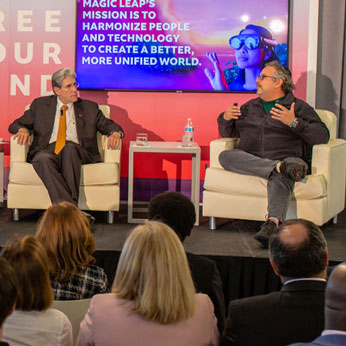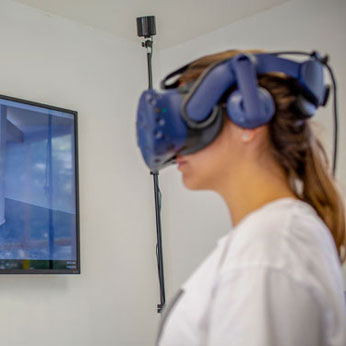TEAMING UP WITH ARTS and SCIENCES
Immediately after its arrival, Henderson had the opportunity to work with two philosophy professors in the College of Arts and Sciences who were eager to introduce virtual reality (also known as VR) assignments into their classes. Brendan and Magdalena Balcerak Jackson brought 35 students to experience immersive virtual reality.
“One of the reoccurring issues of [my intro to metaphysics course] is the distinction between reality and appearance, so we used VR as a way of exploring that difference,” said Brendan Balcerak Jackson, assistant professor in the Department of Philosophy.
“Philosophy is about studying human mental life and the different experiences we have. It really made sense to partly learn about how certain mental states are felt by confronting the students with completely new types of experiences,” said Magdalena Balcerak Jackson, also an assistant professor of philosophy. “Sometimes when you do something new, you’re much better at observing and reflecting on that experience than if the experience is familiar.”
Through the virtual reality explorations within their courses, the two created a new first-year seminar together, titled Immersive Experience and Virtual Reality. It was launched this fall.
“Our goal was to design a whole class about the various obstacles that come up with virtual reality becoming more and more popular in our world,” said Magdalena Balcerak Jackson.
Current research suggests that having new experiences makes us happier in life. Traditionally, traveling the world, meeting different people, and learning new skills were good ways of reaching that goal—sitting in front of a computer screen was not. Recent technological advances are making it possible to have more and more immersive and real-life experiences in virtual reality. During the semester, students also discuss ethical and metaphysical challenges computers pose, along with the opportunities they present for learning, problem solving, and improving human interaction.
“VR allows you to get out of your skin in a much more fundamental sort of way. There are experiences where you could become a robot, experiences where you could switch genders and even your skin color,” said Magdalena Balcerak Jackson. “It allows people to reflect and really feel how different it is when you mentally project yourself onto someone else.“
At the end of the course, the professors hope students will be able to competently explain the main philosophical debates related to the use of immersive and VR devices.
“We are just starting to figure out how many different ways people can use VR for teaching and researching purposes. We’re at a point where we are just getting our feet wet in terms of everything we could possibly do in the future. Every time we teach a course we think of more and more ways in which we can incorporate VR into the class,” said Brendan Balcerak Jackson.
Karen Mathews, assistant professor in the Department of Art and Art History, is another professor who has worked with Henderson to implement virtual reality into her coursework. She teaches Art History Survey, which is an introductory class based on the “greatest hits” in art.
“I have taught this course for over 20 years, and as a professor you are always looking for compelling new ways to present course material to students,” said Mathews.
This fall Mathews incorporated two virtual reality assignments. The first centered on ancient sculptures. Students visited the VR Museum of Fine Art, which is a software program where a number of famous works of art are arranged in a virtual gallery.
“The virtual gallery brought together monuments you could never see in one place,” Mathews said. “The students were able to view the objects, walk around them and could see the various angles and perspectives of the sculptures.”
In the second assignment, students were tasked with studying three important architectural complexes from the ancient world. They used Google Earth VR software to fly over these buildings and switch back and forth between aerial and street views. Mathews said the feedback from the students to both exercises was overwhelmingly positive.
“They marveled at the quality of the images and the lifelike feeling of standing in the museum. They enjoyed the real, visceral quality of the experience as if they were really in front of these artworks,” said Mathews.
Mathews believes VR has the potential to completely revolutionize the teaching of art history.
“These technologies have such great potential in terms of connecting students to educational content and allowing them to interact in virtual worlds,” she said, offering that she hopes to add more technology into her class in the future.
CREATIVE STUDIO
Another way students can learn more about VR is through the Creative Studio located in the “Create” area of the Learning Commons on the first floor of the Richter Library. The space, which is always evolving, is managed by Vanessa Rodriguez, the digital and emerging technologies librarian.
“The Creative Studio is a multimedia lab that is open to everyone on campus. It’s a place where you can seek help creating multimedia projects,” said Rodriguez. “Part of my role is to constantly research the latest technology. I try to provide new tools to help the university grow.”
Summer 2018 was a turning point in the right direction for the studio after the Faculty Learning Community made the decision to add more 3D technologies due to increased demand. Both Henderson and Rodriguez collaborated with the FLC to propose that the studio should include an Oculus Rift (a kind of virtual reality headset), two VR ready computers, an Oculus Go (a different type of virtual reality headset), and an attachment for the HTC Vive. Students can now check out some of these products and take them home for assignments.
“Part of the reason why the Creative Studio was created in the library was because the library is common ground. Everyone feels comfortable coming to try out all of the new products,” said Rodriguez.
According to Rodriguez, there is an increased interest from students for these new high-tech gadgets. She said the next phase of remodeling in the library will include a virtual reality studio.
“We anticipate that technologies will continue to be incorporated into the library’s public service programs,” said Eckman.
Photo and video: T.J. Lievonen/University of Miami






